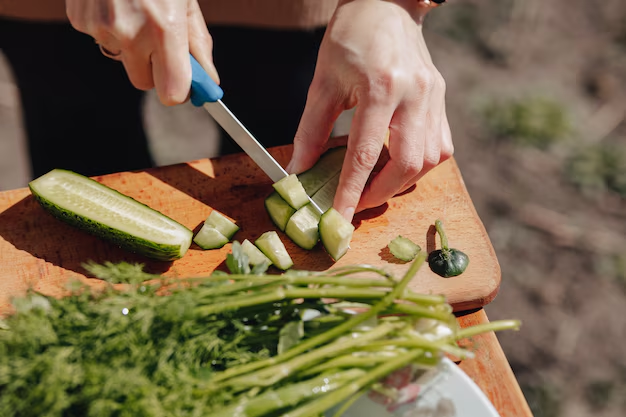How to Extend the Life of Your Scallions: A Comprehensive Guide to Freshness
Scallions, also known as green onions, are a kitchen staple for many. Their mild flavor and crisp texture add a special touch to salads, soups, and stir-fries. Yet, one common frustration for scallion enthusiasts is keeping them fresh. All too often, these delicate greens wilt prematurely in the fridge, leading to wasted produce and unwanted trips to the grocery store. By following a few simple storage techniques, you can dramatically extend the life of your scallions, ensuring they remain vibrant and ready for your culinary adventures.
Understand Your Scallions
Before diving into the techniques, let's first understand what makes scallions unique. Scallions are members of the Allium family, which also includes garlic, onions, and leeks. Their flavor is milder than traditional onions, and they are prized for their tender green stalks and white bulbs. This unique structure, however, means scallions are more prone to moisture loss and wilting.
Anatomy of a Scallion
- Green Tops: These are used for garnishing and adding mild flavor.
- White Bulbs: The part that is closest to the roots, often used in cooking for a slightly stronger taste.
Understanding the anatomy is crucial because different parts have slightly different storage needs.
The Perfect Storage Conditions
The key to keeping scallions fresh lies in creating the right environment. They require moisture, insulation from air, and consistent cold temperatures.
Step-by-Step Scallion Storage Guide
Moisture Retention: Scallions thrive in a slightly humid environment. Begin by gently rinsing them under cold water to remove any soil or residue.
Dry Carefully: After rinsing, pat them dry with a paper towel. Excess moisture can encourage rot, so ensure they are not damp.
Wrap & Store: Wrap the clean, dry scallions in a damp paper towel, then place them in a plastic bag or reusable silicone storage bag. Ensure the bag is not completely sealed to allow some air circulation.
Store Upright: If space allows, stand the wrapped scallions upright in a glass or jar with a small amount of water. Cover the top loosely with a plastic bag to maintain humidity.
Refrigerate: Place them in the vegetable crisper drawer in your refrigerator. Consistent cold temperatures keep them fresh longer.
Alternative Storage Methods
Using a Wet Paper Towel
- Wrap the scallions in a damp paper towel, place in a zip-lock bag, and store in the crisper drawer.
Jars with Water
- Similar to a bouquet of flowers, place the scallions in a jar with an inch of water. Cover loosely with a plastic bag before refrigerating.
Mason Jar Method
- Use a mason jar filled with a bit of water. This method allows for easy inspection and ensures the scallions stay hydrated.
Creative Ways to Use Scallions Before They Spoil
Even with the best storage techniques, scallions can't last forever. Here are some creative ideas for using them:
- Herb Butters: Finely chop scallions and mix with butter for a flavorful spread.
- Scallion Pesto: Use them as a base for a unique twist on traditional pesto.
- Scrambled Eggs: Add diced scallions for a refreshing lift.
- Stir-Fries: Their mild flavor pairs well with any vegetables and proteins.
Summary of Key Tips for Keeping Scallions Fresh 🥒
- Humidity: Keep your scallions moist, but not wet, by wrapping them in a damp paper towel.
- Cool Environment: Ensure they are stored at a consistent, cool temperature in the crisper drawer.
- Partial Airflow: Allow limited air circulation to prevent condensation and wilting.
- Alternative Methods: Use a jar of water method for longer-term storage.
Troubleshooting Common Issues
Yellowing or Wilting
- Cause: This often results from either too much or too little moisture.
- Solution: Check the dampness of the paper towel and adjust as necessary. Replace water if using the jar method.
Slimy Texture
- Cause: Typically a result of excessive moisture and inadequate airflow.
- Solution: Ensure there is proper airflow. Adjust the wrapper to allow more circulation or replace a sealed bag with a breathable one.
Mold Growth
- Cause: Too much moisture trapped in a sealed environment.
- Solution: Replace the damp paper towel often and ensure you’re storing the scallions in a dry, airy bag.
Beyond Scallions: General Tips for Storing Other Fresh Produce
Maintaining perfect storage conditions can be tailored to a variety of produce types. Here are general tips:
- Leafy Greens: Similar to scallions, use a damp paper towel to roll them and store in a breathable bag.
- Root Vegetables: Keep in a cool, dark place, away from direct sunlight.
- Tomatoes: Store them at room temperature and avoid refrigeration for better flavor.
The Bottom Line
Storing scallions effectively is about balancing moisture, air circulation, and temperature. By using these strategies, you can prolong their freshness, reduce food waste, and have delicious, crisp scallions on hand whenever you need them. Whether you’re a seasoned chef or a home cook, understanding how to store your produce properly is an essential skill for any kitchen maestro. With this guide, you're equipped to make the most of your scallions and keep them fridge-fresh for longer.
Effective food storage is as much an art as it is a science. By incorporating these tips into your routine, you not only extend the shelf life of your scallions but also enhance your culinary repertoire, ensuring every meal is infused with just the right amount of freshness and flavor. Happy cooking!
